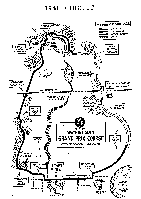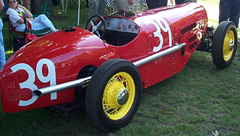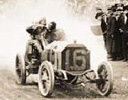The Ardent Alligator and The 1949 Watkins Glen Grand Prix
by Russell Jaslow
It started life out in 1929. Twenty years later, in a different country, with a different engine,
a different body, and a different name, it would win a race in a small community in upstate New
York in the Finger Lakes region that would soon become synonymous with road racing in America.
The car was the Ardent Alligator, and the race was the Watkins Glen Grand Prix.
The car was built in England as a Riley Brooklands with an 1100cc engine
capable of producing 55 hp. It was purchased in 1934 by Miles Collier, who along with
his brother, Sam, founded and raced in the Automobile Racing Club of America (ARCA), the
premier road racing sanctioning body before WWII. The car was green at this time and being from
the Florida Everglades region, they named it the Ardent Alligator.
The car was stored between 1935 and 1939, whereupon it received a new body and a new engine,
a Mercury 3.9 liter V-8 flathead and drivetrain producing 175 hp. The War forced the car to go
back into storage until 1949.
|
A group of sports car enthusiasts organized the Sports Car Club of America (SCCA) soon after
the War had ended. Their initial purpose was to preserve and enjoy the sports car. They had
no plans to enter the racing game. However, with ARCA showing no signs of being revived and
many of their prominent members joining SCCA, the new club was talked into organizing and
promoting a race in Watkins Glen being proposed by Cameron Argetsinger.
|
 The map of the original Watkins Glen circuit. To see a full size map, click
on the image.
The map of the original Watkins Glen circuit. To see a full size map, click
on the image. |
The 1948 race was a great success, and the idea spread in 1949. Organizers in Bridgehampton
staged a road race through the streets of that small town on the Eastern end of Long Island.
The Ardent Alligator returned to action. Miles Collier drove the car, but it did not
finish. However, Collier was still confident in its ability.
He entered it in the 1949 Watkins Glen Grand Prix to be run on the same course as the inaugural
event, a 6.6 mile layout that resembled a miniature Nurburgring with its extreme elevation
changes, breathtaking blind turns, and flying "ramps" over railroad tracks. This year, the
main event would be nearly doubled from 8 laps to 15.
 The Ardent Alligator as it appears today. For a full size image, click on
the picture.
The Ardent Alligator as it appears today. For a full size image, click on
the picture. |
There was no practice or qualifying, so the starting order was done by a draw. Miles Collier
was unlucky to pick the 12th starting position. Unlike the preliminary Seneca Cup race which
used the classic "Le Mans" start, the main feature would begin with a standing start in rows of
two on Franklin Street. Honorary starter, Wilbur Shaw, stood by as the flag was dropped.
Collier got off to a poor start and immediately dropped back to 17th.
By the end of the first lap, Collier worked his way to 14th, but a minute back from the leader.
He started to make his move on the second lap passing ten cars to move into fourth, a few car
lengths behind third. Collier would take third early on the next lap, but still found himself
51.8 seconds behind the leader.
The race started to become one of attrition on the fourth lap as many of the 43 starters began
to drop out. However, this was all behind Collier, continuing to chase the two leaders
but not making any headway. Collier would remain in third place for the next nine laps and found
himself 49.6 seconds behind the leader at the completion of the 13th lap. Then began one
of the most stirring and thrilling comebacks ever seen at Watkins Glen on any of the many course
configurations.
The leader through most of the race was Briggs Cunningham driving a Ferrari. This was only the
second time a Ferrari was seen on these shores, having made its debut at the Bridgehampton race.
Behind Cunningham was another car he owned, a BuMerc, so named because it was a Buick Century
chassis and 5.2 liter V-8 engine inside a modified Mercedes SSK body, driven by George
Roberts.
Cunningham held a healthy lead until the start of the 14th lap. Roberts finally
used the extra torque in his machine to catch Cunningham going up the long hill. Roberts made
a pass attempt on the straight just after the railroad crossing that began a brilliant wheel to
wheel duel. Over the narrow stone bridge, over the railroad crossing, past Friar's Corner, and
down into Big Bend. Cunningham put an end to this battle using his experience and the superior
handling of the Ferrari, and arrived back at the Start/Finish line with a 15.5 second lead.
Little did either of them know, that while they were battling with what they thought was for
victory, Miles Collier in his Ardent Alligator had turned up the wick. Collier completed
lap 13 in a new lap record of 5:39.0. He would lower that record on lap 14 by an astounding 14.5
seconds with a time of 5:24.5. And he wasn't done.
Now within sight of the two leaders, Collier pressed on. He caught Roberts and the BuMerc
going up the hill towards White House Corner, making the pass for second after the railroad
overpass. He then set his sights on the leader.
Collier was within a few car lengths as they got to the railroad crossing. Both cars flew over
the tracks, literally, as they would launch the faster cars completely airborne. Collier was on
Cunningham's tail going into Big Bend, an extremely long, quick downhill right hand sweeper. It
ends with a ninety-degree left hand turn, still going downhill, called Milliken's Corner, thanks
to the luckless Bill Milliken who flipped his car there the previous year.
Collier made his move. Shortly after Milliken's Corner was a ninety-degree right hand
turn leading onto Franklin Street. The front straightaway crowd saw Collier come out of that
turn with the lead, and he stretched the margin to 8 seconds by the finish line. Cunningham
finished second, just ahead of Roberts. To add icing to the cake, Collier broke the track record
again with an even more amazing time of 5:12.2 for an average speed of 75.38 mph, nearly 7 mph
faster than the previous year's record.
1949 proved to be the Ardent Alligator's most memorable moment, but it continued to be
raced often. Miles Collier entered the car in events at Boca Raton, Florida and again at
Bridgehampton. Sam Collier drove it at the Mt. Equinox Hill Climb in Vermont in a record time
that stood for many years. It returned to Watkins Glen for the 1950 Seneca Cup where it finished
third overall, first in Class C, despite Miles running into the haybales and only having high gear.
It was not eligible for the Grand Prix because the race was now approved by the FIA, thus run
under their rules, and the car could not carry a spare wheel, an FIA requirement. Sam Collier
would be killed in the 1950 race while leading, and Miles immediately retired from driving.
Bret Hannaway took ownership of the car and entered it in the 1952 Watkins Glen Grand Prix, but
the race was stopped after one lap when a seven-year-old spectator was killed and twelve others
injured by a wayward car. George Robe bought the car, and raced it on the first permanent Watkins
Glen course in 1954 and 1955. 1954 also saw the death of Miles Collier from natural causes.
The car was owned by J.D. Engleheart in the 1960's when it was damaged in a fire. Bill O'Donnell
got his hands on it next and began restoring the car. Don Lefferts drove it in vintage events.
Current owner, Peter McManus, finished the restoration to it's 1949 state including the red paint
and number 39.
Results of The 1949 Watkins Glen Grand Prix
| 


